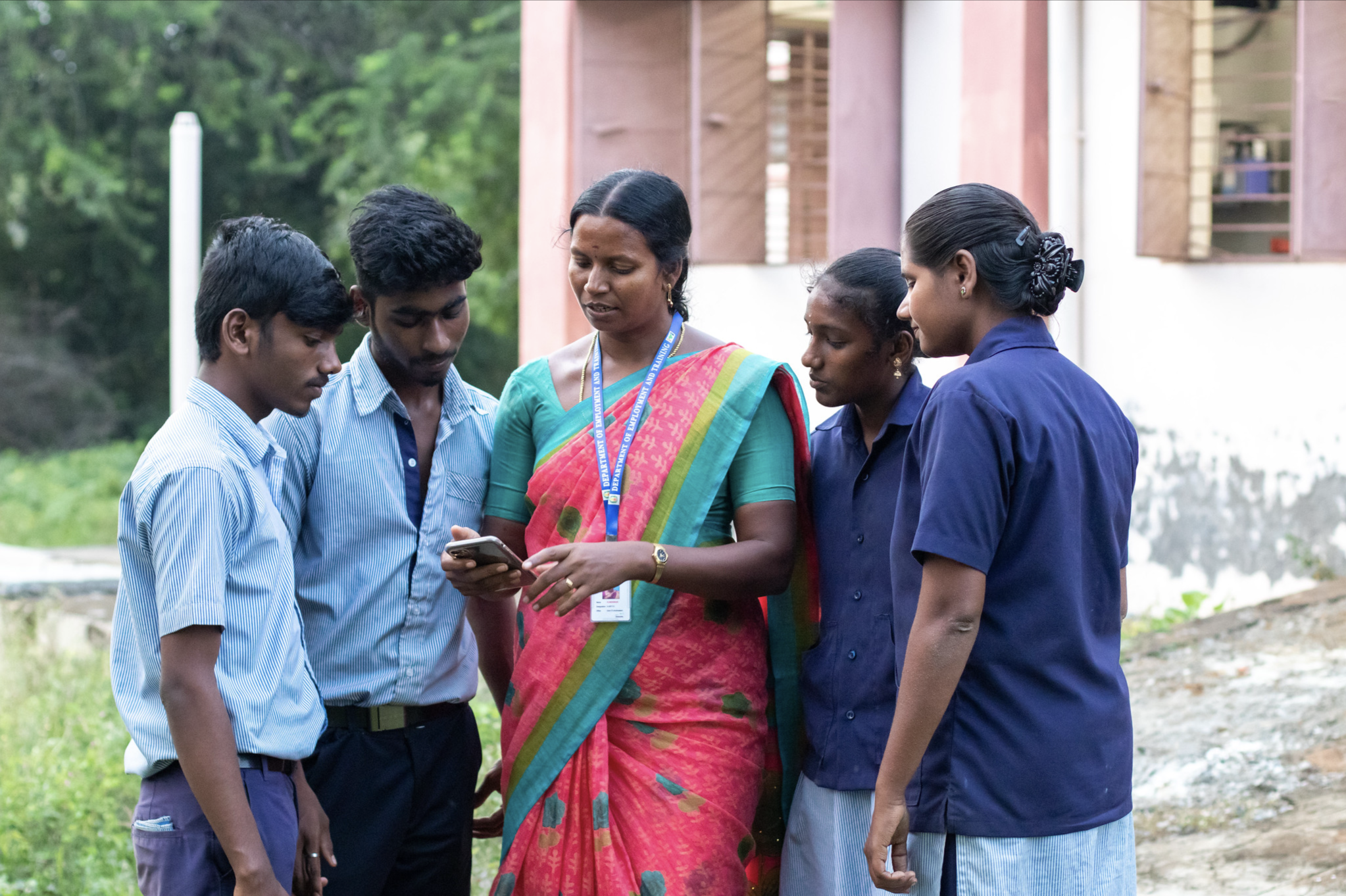Purposeful StoriesFebruary 2024
Sustaining
Hope
The word sustainability is no longer unfamiliar to us. Currently, it is an essential part of our vocabulary. To achieve a better and more sustainable future for all, the SDGs 2030 are the blueprint. In this edition of our newsletter, we investigate how individual actions matter and sustain hope for one and all.
What’s Hope Got to do with it?
In the penultimate scene from Lagaan (2001), Bhuvan, Amir Khan’s infectious, reckless optimist falls back on something humans often do—hope. The voices of those closest to him ring in his ears; he closes his eyes as the ball is being delivered to him. Then, he swings his bat and hopes for the best – hopes that his team, an underdog in comparison to the much more formidable English cricket team, scripts a miraculous victory and that his people are no longer coerced to pay the backbone-breaking triple taxes to their colonisers.
Funnily enough, the way this scene is written also sees the audience in this moment hoping for a heroic result with bated breath. As Captain Russell catches the ball, I remember hoping, in the theatre, that this wasn’t the end. Surely, there was a silver lining. And so there was, for the collective hope of the characters in the film and us, the audience, to bear fruit when the rag-tag Indian team wins against all odds. A characteristic David and Goliath story!
“Hope is a good thing, maybe the best of things,” said Andy Dufresne from Shawshank Redemption. A film that has since become a cult classic for all the right reasons embodies what it means to cling on to hope, the fuel that has since the beginning of time made the world go round.
For a mere four-letter word “Hope” carries immense weight, encompassing everything from placing faith to awaiting a positive outcome to the unwavering conviction that things might improve. To be hopeful is to not surrender in the face of an adversity, to keep aflame the spark of the spirit that pushes athletes to get back up after a fall and keep going, the strength that fuels a social worker fighting injustice, and the resilience that allows a farmer to sow seeds despite a failed harvest. Yes, that never-say-die attitude.
Hope has always been inherent to humanity. We are wired to seek a better tomorrow. It’s woven into the very fabric of our stories, from the myths of Icarus, who hoped to fly to freedom from King Minos’s captivity, films like Shawshank Redemption to even the likes of the popular track from Gully Boy (2019), hope that “Apna Time Ayega” (our moment will arrive) is the foundation on which dreams are built and the action to materialise those dreams is taken.
It begs the question though, why is hope so crucial? It guarantees nothing, expects wholehearted dedication and can often disappoint. Yet, hope is the engine that drives progress. One generation hopes to build a better tomorrow for their progeny and so on it goes. It’s what has given us ground-breaking inventions and helped innovators, creators and builders to materialise their ideas into reality.
It’s no surprise then that the one space in which hope is the most crucial factor is climate action. Without hope, the fight for a greener future would falter, rising temperatures may cast a long shadow, and despair can easily take root. It is in these moments when hope becomes our most potent weapon. I hope using a glass straw means our oceans will be slightly cleaner. My friends hope that if they recycle their clothes, there will be less garbage in the dumps. We hope that all of us are capable of making a difference.
That said, I am not advocating blind optimism sans action. Perhaps the memorable Shawshank dialogue needs a 21st-century revamp: “Hope is a good thing. But when it comes to the planet, just hope maybe isn’t the best of things.”
The cocktail for a greener tomorrow, then, also needs a healthy proportion of purposeful and hopeful action. And to delve deeper into some of the best action in that direction, here are some hopeful stories to brighten your day....
Preserving Chinars for posterity
Zareef Ahmad Zareef, a well-known cultural commentator and satirist-poet based in Kashmir’s summer capital Srinagar, is the epitome of hope, courage, and conviction. His satirical one-liners leave audiences—young and old—in stitches and his acts of kindness offer hope for a better tomorrow. Zareef keeps the hope alive for a sustainable future by planting more and more maple (Chinar) trees across every nook and cranny of the valley. In this noble endeavour, the octogenarian activist is not alone.
Zareef’s ‘Save Chinar’ initiative continues to gain momentum amid civil society support. Hence the local government could no longer afford silence or inaction. It immediately formed a separate Chinar Development Authority.
“Chinar is our cherished treasure. Kashmir’s soil is fertile. The tree reflects our conscience. It is our moral duty to save Chinar by planting Chinar,” Zareef tells Gnothi Seauton in an exclusive chat. Though he laments how factors including urbanization, expansion, unplanned construction works and pollution are posing a significant threat to the existence of this iconic tree, he says hopelessness or helplessness is not the solution.
Zareef refuses to abandon hope. Describing Chinar as “Kashmir’s cultural heritage”, the satirist-activist underscores the need to intensify the movement to preserve Chinars for posterity. As part of the Zareef-led ‘Save Chinar’ (Booune Bachav Tehreek in Kashmiri) movement, civil society activists, environmentalists and concerned citizens are planting maple trees at multiple locations to preserve the rich legacy.
Originally a Persian word and also spelled ‘Cinar’, the word means ‘flame’. Platanus Oriental or “Booune” in Kashmiri language is linked to Kashmir’s 5000-year-old civilization. According to historians, Mughal emperor Jehangir gave this name (Chinar) to the maple tree in Kashmir. The Mughals are often credited for accelerating plantation of many Chinars in decorated Nishat, Shalimar and Harvan gardens (also known as the Mughal gardens), adding flavour to the valley’s already stunning landscape. Historians note that Mughals ordered plantation of over a thousand Chinar trees along the embankment of the Dal Lake and Naseem Bagh in Srinagar; Anantnag, Kokernag and Bijbehara towns in southern Kashmir; and in Budgam in central Kashmir.
In Kashmir, maple plantation is also found inside the compounds of famed shrines. Currently, one of the valley's oldest Chinars is found near a mosque in the Chattergam area in central Kashmir’s Budgam district and another one in Padshahi Bagh in south Kashmir’s Bijbehara town.
Kashmir’s picturesque landscape is marvelled at in all seasons. Thanks to the majestic Chinars, the valley looks dazzling in autumn. Aesthetically pleasing Chinars are one of the major attractions for natives and tourists alike, in the autumn season. Agha Shahid Ali, an outstanding Kashmiri-American poet, in one of his epic poems titled The Last Saffron wrote: “I will die, in autumn, in Kashmir.”
From original green, the maple leaves turn crimson-red and become a source of attraction for those who appreciate the magic of colours. Not only does the Chinar tree add to the valley’s charm, it is also a symbol of ecological heritage, besides holding spiritual importance. Unfortunately, the number of maple trees is fast dwindling, thus setting the alarm bells ringing, particularly among environmentalists, cultural activists, and civil society coalitions.
Official apathy and public greed are cited by experts as the two major factors behind the diminishing numbers of Chinars. According to the region’s floriculture department, there are currently only 35,000 Chinar trees left in Kashmir. From an estimated 50,000 in the 1980s and 42,000 in the 1990s, the number of maple trees has drastically reduced. Independent estimates put the number of Chinara to less than 20,000, with at least one-third of these diagnosed as damaged or diseased in a census conducted by the Forest Research Institute (FRI) in 2023. In his book, The Trees of Our Heritage, Kashmir’s former chief conservator of forests Muhammad Sultan Wadoo records that only 17,124 Chinars are left in Kashmir, of which more than 700 are chopped annually.
Chinars are, no doubt, fighting a battle for survival. However, people like Zareef and environment and RTI activists such as Abdul Hamid Bhat and Dr. Sheikh Ghulam Rasool are refusing to give up.
“Unfortunately, Chinars have become primary victims of unplanned construction and town planning. But we, as comrades of Zareef Sahib, are not giving up. We are a part of his ‘Save Chinar’ initiative. We have fixed a target of planting at least 100 Chinars annually,” says Dr. Rasool. About 20 species of birds find protection and home near Chinars, he adds.
According to Abdul Hamid Bhat, Chinar is “our identity” and to keep this identity intact, “we have to keep planting these trees”. Bhat has planted over 5000 Chinars over the last two decades or so. “We have to preserve this tree for our coming generations!”
Iqbal, an eminent poet, in his verses, used Chinar as a metaphor for Kashmir’s consciousness.
Jis khaak ke zameer main ho aatish-e-chinar
Mumkin nahin ki sard ho woh khaak-e-arjumand
(The dust that carries in its conscience the fire of Chinar, It is impossible for the celestial dust to cool down)
Future-ready GenNext
Although academic skills and co-curricular activities remain critical for overall growth of India’s youth, these are inadequate to survive in today’s AI-driven world. Three decades back, career choices were limited but the youths were more or less determined as far as their ultimate goal was concerned. This mindset is witnessing an unprecedented transformation, as flexibility, adaptability and willingness to improve skill sets are key drivers for today’s youth.
With technological expansion, the world around us is witnessing change and posing new challenges for students preparing for careers of the future. Quest Alliance, a non-profit trust, is equipping India’s young people with the right mindsets, attitudes and agency, empowering them to imagine alternative thriving futures.
At Quest Alliance, the approach is to promote career exploration and support career transitioning so that India’s youth are better equipped to navigate their career journey challenges with ease. In the existing labour market, satisfaction, they say, is the death of desire. The young have to constantly upskill for relevance. All of us understand that the rosy picture of technological adoption has its thorns, too.
Aakash Sethi, Education technology leader and social entrepreneur from India’s southern state of Karnataka, is empowering unemployable youth to navigate the future of work. In an e-mailed conversation with Gnothi Seauton, Sethi notes that at Quest Alliance, the rewarding experience of work with the youth has revealed a stark reality that India’s young people face. “They feel little agency in deciding their futures and have to passively accept and adapt to the futures decided for them. This realization sparked a journey of exploration to understand how Indian youth envision their futures and what the role of Futures Thinking is in empowering youth to imagine alternative futures where they are thriving.”
One of the many blessings of modern technology is that the young girls and boys have information available to them at their fingertips. Quest Alliance has travelled to different Indian states– Assam in the northeast, Gujarat in the western part and Odisha in the east– to pilot Future Thinking pedagogy that enables the young to imagine the future they desire. “At its core, Futures Thinking, as a skill, is not about predicting the future, rather about cultivating the capacity to imagine and shape multiple futures by deciding the desired future they want to build,” argues Mr. Sethi.
Mr. Sethi gives an example from the field of welding. Traditionally, he says, a welder’s job was to simply weld. However, with the integration of AI and automation, welders are now required to provide instructions to machines, effectively becoming collaborators with technology. This shift, Mr. Sethi insists, necessitates not only technical skills, but the ability to adapt to new ways of working. Creativity, adaptability, innovation, the courage to try out new things and flexibility for upskilling, reskilling and retraining remain decisive factors. Individuals are provided the necessary support to be in the driver’s seat, enabling them to navigate the journey of continuous learning, unlearning and development.
The organization addresses this need through learning methodologies and two flagship products: the Personalized Learning Engine (PLE) and Career Quest. Through PLE, Mr. Sethi says, students are encouraged to break free from conventional career stereotypes and explore a diverse range of employment types, industries, and career pathways.
This form of thinking paves the way for students to remain open to all sorts of possibilities, appreciating the fact that the future is not predetermined but can be shaped by concrete actions performed today. Additionally, Quest Alliance has built green ITIs (the Industrial Training Institute) ecosystem on a pilot basis across India. The focus is on a ‘green lens’, motivating learners to consider the environmental impact of their actions and seek sustainable solutions to regional and global challenges. Students are also encouraged to pursue meaningful careers that contribute to environmental sustainability. Importantly, a green curriculum introduces learners to the concept of green careers. This not only enables students with knowledge and tools to take timely climate action, but also view the planet through a climate lens.
To build a sustainable future, we need to be cognizant of whose futures we are thinking about and whose futures are being left behind. Futures Literacy enables us to question our own assumptions of the narratives of futures we hold, and urges us to imagine and create a future that is just, inclusive and participatory.
The programmes, in short, nurture critical thinking, creativity, problem-solving, communication, and collaboration skills that are essential for thriving in the future workplace. By integrating STEM education with themes like gender equity and environmental sustainability, Quest Alliance ensures that learners are not only proficient in their chosen fields but also socially and environmentally conscious individuals who embrace change without fear and with the necessary knowledge.
On this positive note, all of us can keep alive hope for future sustainability, for sure.
Curated Reads
Podcast
School of Purpose: Episode 12
Roadmaps to Resilience: Empowering Youth for Change
In this episode of School of Purpose, we delve into the remarkable journey of Jayant Rastogi, Global CEO of Magic Bus India Foundation. In an engrossing conversation, Jayant shares the pivotal moments that have shaped his path towards creating positive social change in the lives of young people from underserved communities. Join us as we uncover the driving forces behind his transition from the corporate sector to the nonprofit world and explore the impactful milestones that have defined his career.











